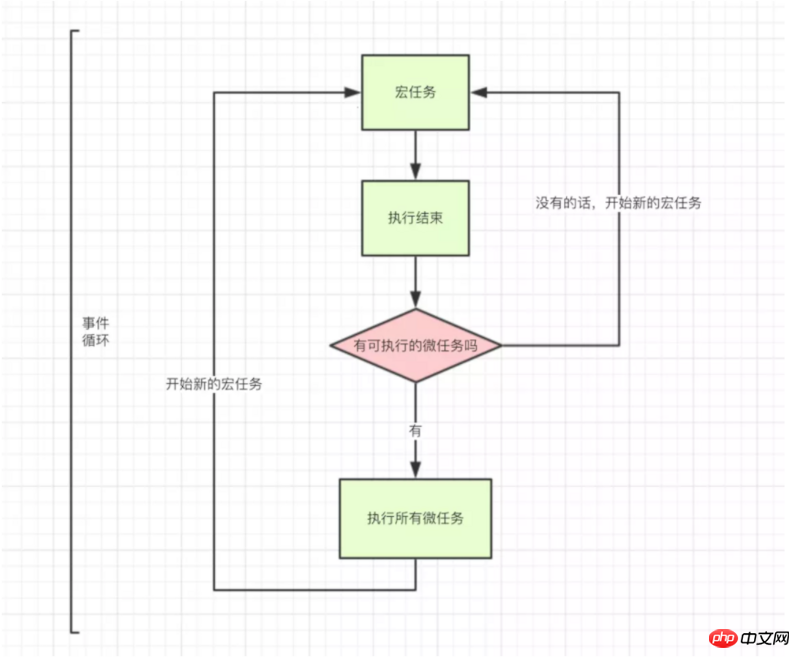
This article mainly shares with you a method of briefly analyzing the JS execution mechanism. It has a good reference value and I hope it will be helpful to everyone. Let’s follow the editor and take a look.
First of all, please keep 2 points in mind:
#(2) The Event Loop of JS is the execution mechanism of JS. A deep understanding of the execution of JS is equivalent to a deep understanding of the event loop in JS
technologies is closely related to application scenarios in the real world.
Similarly, we will answer these three questions based on real-life scenarios
(1) Why is JS single-threaded?
JS was originally designed to be used in browsers, so imagine if JS in the browser was multi-threaded.
|
1 2 3 4 5 |
: So now there are2 processes,process1 process2 ,Because it is a multi-processJS,so they operate on the same dom,at the same time process1 Deleted the dom, and process2 Edited the dom,issued 2 contradictory commands at the same time,How should the browser execute it? |
|
|
: If asynchronousdoes not exist in JS, can only Top-down execution,If the parsing time of the previous line is very long,then the following code will be blocked. For users,blocking means"stuck",This leads to a poor user experience |
So, there is asynchronous execution in JS.
(3) How does single-thread JS achieve asynchronous implementation?
Since JS is single-threaded, it can only be executed in one thread How to implement asynchronous execution?
is through the event loop (event loop). If you understand the event loop mechanism, you will understand the execution mechanism of JS
Example 1, observe its execution sequence
console.log(1)
setTimeout(function(){
console.log(2)
},0)
console.log(3)The running result is: 1 3 2
In other words, the function in setTimeout is not executed immediately, but is delayed for a period of time and is executed only after certain conditions are met. This type of code is called asynchronous code.
So, here we first know a classification method in JS, which is to divide tasks into: synchronous tasks and asynchronous tasks
Picture description
According to this classification Method: The execution mechanism of JS is
First determine whether JS is synchronous or asynchronous. If it is synchronous, it will enter the main process, if it is asynchronous, it will enter the event table
The asynchronous task registers the function in the event table. When the trigger condition is met, it is pushed into the event queue
The synchronous task enters the main thread and is executed until the main thread is idle. Check the event queue to see if there are executable asynchronous tasks. If there are, push them into the main process
The above three steps are executed in a loop. This is the event loop
So for the above example, can you describe its execution sequence?
| console.log(1) is a synchronization task,put it in the main thread setTimeout() is an asynchronous task , is put into event table, 0 will be pushed into event queue seconds laterconsole.log(3 is a synchronization task ,Put it in the main thread
When 1、 3 is in After the control bar is printed, , the main thread goes to event queue(Event Queue) to see if there is any The executed function,executes the function |
所以,上面关于event loop就是我对JS执行机制的理解,直到我遇到了下面这段代码
例2:
setTimeout(function(){
console.log('定时器开始啦')
});
new Promise(function(resolve){
console.log('马上执行for循环啦');
for(var i = 0; i尝试按照,上文我们刚学到的JS执行机制去分析
1 2 3 4 5 6 7 | ##setTimeout is an asynchronous task , is placed in event table new Promise is a synchronous task, are placed in the main process , Directly execute printing console.log('Execute the for loop now') .then# The function in ## is asynchronous task, is placed in event table console.log('Code execution ends') is the synchronization code , is placed in the main process , is executed directly |
So, the result is [execute the for loop immediately - the code execution ends - the timer starts - the then function is executed]?
After executing it personally, the result is not like this, but [execute immediately The for loop - the code execution ends - the then function is executed - the timer starts]
So, is it the execution order of asynchronous tasks, not the order before and after, but other regulations? In fact, according to asynchronous and The synchronization division method is not accurate.
The accurate division method is:
macro-task (macro task): including the overall code script, setTimeout, setInterval
micro-task (micro-task): Promise, process.nextTick

1 2 3 4 5 6 7 8 9 10 11 12 13 14 | First execute the macro task under script,encounters setTimeout,put it in the [queue] of the macro task
Encounter new PromiseDirectly execute ,print "Execute the for loop immediately"
Encounterthenmethod,is a microtask,Put it into the microtask [queue]
Print "Code execution ends"
This round of macro tasks has been executed,Check the current round of micro tasks,It was found that there is a function in the then method, Print"The then function is executed"
This is it,This round's event loop All completed.
下一轮的循环里,先执行一个宏任务,发现宏任务的【队列】里有一个 setTimeout里的函数,执行打印"定时器开始啦" |
所以最后的执行顺序是【马上执行for循环啦 — 代码执行结束 — 执行then函数啦 — 定时器开始啦】
这段setTimeout代码什么意思? 我们一般说: 3秒后,会执行setTimeout里的那个函数
setTimeout(function(){
console.log('执行了')
},3000)但是这种说并不严谨,准确的解释是: 3秒后,setTimeout里的函数被会推入event queue,而event queue(事件队列)里的任务,只有在主线程空闲时才会执行。
所以只有满足 (1)3秒后 (2)主线程空闲,同时满足时,才会3秒后执行该函数
如果主线程执行内容很多,执行时间超过3秒,比如执行了10秒,那么这个函数只能10秒后执行了
The above is the detailed content of A brief analysis of JS execution mechanism. For more information, please follow other related articles on the PHP Chinese website!




